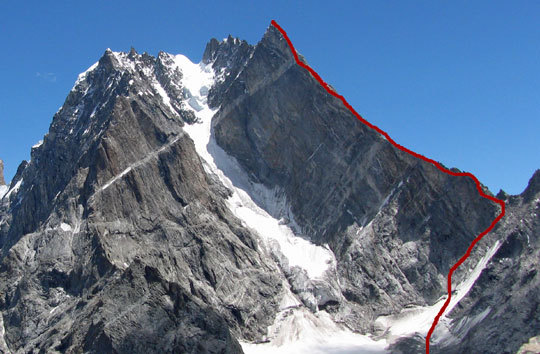
Previously unclimbed Peak 5960m, with the Americans’ route up the west ridge indicated in red. The route took two attempts to complete; the team’s first attempt was shut down by a snow storm at ca. 5680 meters. Pat Goodman, Freddie Wilkinson and Dave Sharratt spent a month in the Miyar Valley, a relatively undeveloped area considering the amount of quality rock present, establishing this route and three others. [Photo] Courtesy of Pat Goodman
Over four weeks in August and September, an American team of three–Pat Goodman, Freddie Wilkinson and Dave Sharratt–established four new routes in the Miyar Valley, Himachal Pradesh, India.
The Himachal Pradesh’s many valleys and glaciers feature a number of peaks that, by Himalayan standards, are relatively low in altitude, most under 6000 meters. The wealth of climbing possibilities here led Sir Chris Bonington to describe it as “the Yosemite of India.” Unlike Yosemite, it has seen relatively little exploration, largely because easy access on roads has been available only in the last ten years.
The American Alpine Journal reports activity in the region since at least the early 1970s, with most or all of the climbing in that decade by the India-Tibet Border Police. In the early 1980s, a few more international teams began investigating the region, including a 1984 Scottish group, which reported finding litter from earlier expeditions. A 1992 Italian expedition sparked much of the current interest, as their pictures and descriptions increased awareness of the number and quality of unclimbed granite peaks in the region.
Arriving at a basecamp below the Miyar Glacier on August 13th, the three American climbers took advantage of great weather and quickly established a new route (5.11, 350m) on the south face of the previously unclimbed Orange Tower (5200m) located on the adjacent Jangpar Glacier.
The unclimbed Peak 5960m was the team’s next goal. The trio left their high camp on the Jangpar Glacier around 1 a.m. on August 24. They climbed a couloir through unstable snow conditions and technical mixed ground for about 1,500 feet on the north face of Peak 5960m to reach a col on the west ridge. Following the ridge, the team found loose, moderate (5.8+) rock, which they simulclimbed to their high point of 5680 meters. A snow storm sent the trio back to base camp.
Hoping to avoid the unstable mixed conditions in the previously climbed couloir, the team moved their high camp to the nearby Dali glacier. On August 29, the team was able to reach the summit of Peak 5960 via the West Ridge (IV+ 5.9+, 660m). Goodman, suffering from what appeared to be a kidney infection, was unable to summit with his two teammates.
The team’s next objective was the unclimbed central pillar of Mt. Mahindra (5845m). September 1, on a route attempted by a team of Italians in 2003, the trio fixed two pitches, then descended. Returning two days later, Wilkinson and Sharratt (Goodman was not with the summit team) completed the entirety of the new route onsight, finding good climbing alternating between wandering face and flake pitches. The route, ascending the south face of Mahindra’s middle summit, they named Ashoka’s Pillar (V+ 5.11 R, 857m).
[Editor’s Note, October 4, 2007: In the 2004 American Alpine Journal, a Slovakian team is listed as having summited a foresummit of Mt. Mahindra (The Last Minute Journey, ED1, 900m). The AAJ of that year suggests that the true summit of the peak is ca. 6000m. Alpinist listed Mahindra as unclimbed based on that information and the following information from the climbers mentioned in this NewsWire. “From the topos we have seen–we did as much research as possible–the Slovaks climbed to a sub-summit on the left–north western–most peak via a mixed route up a gully. We wondered why they chose to stop at a point so close–ca. 100m??–to the top of the left summit, although Dave [Sharrat] and Fred [Wilkinson] said the rock on that summit looked rotten. The AAJ states this as well, as does a recent article about the Miyar Valley in Desnivel, # 238 June 2006. The article is great and has color photos of every known route in the Miyar. On the summit, Fred and Dave saw no sign of another ascent. They went all the way to the top of the middle summit; the aformentioned elevation of the peak is inacurate, more like 5845 meters. I would speculate this could only be clarified by Dodo and Ivan, not by anybody else…”, said Goodman via email. Alpinist is continuing to research this story and encourages further comment on this story by the parties involved in the original ascent of Mt. Mahindra.]
Despite suffering from the aforementioned kidney infection, Goodman completed his own first ascent the same day. The climbing was mostly moderate, following high quality featured rock on the south ridge of Peak 5300m. Goodman free soloed the route, which he named P.K.D. (III+ 5.9-, 550m), in about eight hours.
[Editor’s Note, October 4, 2007: Alpinist would like to continue the coverage of this story by indicating that a full report of the trip, made by Wilkinson, can be read on our Reader’s Blog.]

Freddie Wilkinson and Dave Sharratt made the first ascent of central pillar of this peak, Mt. Mahindra (5845m), via the indicated route, Ashoka’s Pillar (V+ 5.11 R, 857m), which ascends Mahindra’s south face. [Photo] Courtesy of Pat Goodman